With the discovery of offshore gas in the Black Sea, Turkey announced on Friday that it is now closer than ever to becoming a country that is far less dependent on foreign gas imports.
Behind this historic feat are years of preparations and procuring of tools and vessels that have made an exclusive state-controlled offshore drilling possible.
Turkish President Recep Tayyip Erdogan said that the country is hoping to "see similar good news in the Mediterranean as well" as the government "accelerate" their drilling operations there, too.
Here's a quick breakdown on Turkey's game-changing vessels deployed for the offshore gas search.
Barbaros Hayreddin Pasa Seismic Vessel:
The vessel joined the inventory of TPAO in 2012. TPAO was established in order to perform hydrocarbon exploration, drilling, production, refinery and marketing activities on behalf of the Turkish Republic with the law 6327 in 1954.
Prior to the purchase of Barbaros Hayreddin Pasa, Turkey was realising such research processes by service procurement. But now, thanks to its own vessel, Turkey manages its own research progresses.
Barbaros Hayreddin Pasa was purchased for $130 million and able to conduct 2D and 3D seismic research. The vessel is capable of collecting data from the maximum depth of 8km underwater and can collect 2D and 3D seismic data.
The total weight of the vessel is almost 5 gross tonnes, it is 84 metres long and its width is 21,6 metres wide. It boasts a heliport, too.
With the ability to work at glaciers, it uses a diesel driving force. With its seismic sound source, high-quality catalytic converters, double hull and water cleaning systems, it is known as one of the most environmentalist of vessels.
MTA Oruc Reis Seismic Vessel:
Being known as ‘Local Success’, its production started in 2012 by local means. In 2017, MTA Oruc Reis got ready for operation tests, training and experience activities.
Equipped with the most recent shipping and manoeuvre systems, MTA Oruc Reis is able to conduct 2D and 3D seismic research.
In addition to oil and natural gas activities, strategically important scientific research, such as the continental shelf in the context of monitoring the continuity of land areas under the sea, can effectively be carried out by MTA Oruc Reis.
The vessel is capable of monitoring geological structures up to 15 metres of depth under the sea, and it is able to collect samples from the water and ground for its own measurements and assessments.
MTA Oruc Reis is 86 metres long and is 22 metres wide. When its fuel tank and food storage is full, it can stay in the sea for 35 days. 28 researchers and 27 crew work in it.
Fatih Drilling Ship:
Fatih is Turkey’s first national drilling ship - it joined the inventory of TPAO in 2017. Following maintenance works, the ship is equipped with a pressure-controlled drilling system. On the 567th anniversary of the conquest of Istanbul on 29 May, Fatih left Haydarpasa Harbour in Istanbul and went to the Black Sea to start Turkey’s first national drilling activity.
Fatih is 229 metres long and is 36 metres wide. It weighs more than 51 gross tonnes. Constructed in 2011 in South Korea, Fatih enjoys 6th generation technology.
The vessel is one of the five biggest drilling ships in the world and it is as long as the Eiffel Tower. Fatih is capable of conducting drilling in waters of up to 12,200 metres deep.
Yavuz Drilling Ship:
Within the context of Turkey’s ‘National Energy and Mine Policy’, TPAO bought Yavuz in 2018. Likewise Fatih, Yavuz is also a 6th generation deep drilling ship 230 metres long, and 36 metres wide.
Thanks to its special design with twin towers, it can conduct multiple operations at once. The construction of Yavuz was completed in 2011 and the ship participated in several operations in Tanzania, Kenya, Malaysia and the Philippines.
It is one of only 16 ships across the world that possesses such qualities and unique attributes.
Kanuni Drilling Ship
In order to unearth Turkey’s hydrocarbon potential, Kanuni will be working in Turkey’s Blue Land (Mavi Vatan) zone. Joining Turkey's fleet at the beginning of 2020, Kanuni was constructed in 2012 and it is 227 metres long and is 42 metres wide. The development process of Kanuni is in place in Mersin’s Tasucu harbour.
Future plans
Ankara aims to extract gas from the discovered Black Sea field by 2023 and data shows the country is likely to find other natural gas reserves in the same sea, according to President Erdogan.
The size of the discovery dwarfs all the natural gas Turkey has ever produced (16.6 billion cubic metres), and is expected to be worth roughly $65 billion in value.
The newest discovery amounts to 320 billion cubic metres of natural gas, thanks to the constant efforts made by the government, as well as the resilience shown by its drillship Fatih, which began its work on July 20.
President Erdogan said that Turkey has long been dependent on foreign companies for oil and gas exploration activities, but the steps taken by Finance Minister Berat Albayrak during his term as Turkey’s energy minister have pioneered the recent discoveries.
























